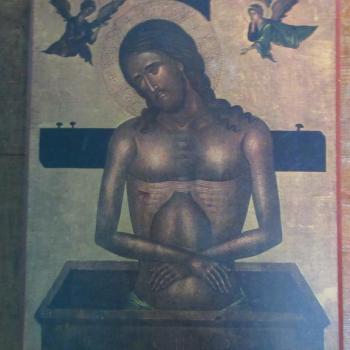I have some really bad news. The world is sinful. Structures of sin surround us. We are socialized into that sin, leading us to form habits of sin before we fully understand what it is we are doing. In part, we know, something is not right, but we follow the crowd and get caught in the sins of the crowd. We become seduced by society, and we are blinded to its failings by being made a part of them ourselves.
Different cultures fall into various sinful behaviors more than others. For us, it is easy to see that among the structures of sin which dominate our society, greed (love for money and not one’s neighbor), pride (individualistic upping of one’s worth in relation to others) and lust (objective desire for the other outside of their own good) are three of the most important. Not only have they become very pervasive, the deeds they make us do are often confused as being either neutral or actually good. We are encouraged to think it is fine to “look out for number one,” to accumulate more than our fair share of the goods of the earth to make sure we can continue to do so, and to enjoy what we can get out of others because it “makes us happy.” But the consequences of our actions are clear; not only do we hurt others, but we end up hurting ourselves. Sin encourages us to follow a limited good at the expense of the greater good, and gives us an immediate sense of pleasure which is followed by a greatest sense of angst and pain.
I do have some good news. Grace allows us to work against sin, and even to help overcome the structures of sin which pervade our society. We must, of course, struggle. We must cooperate with grace, and use it to overcome the root causes of sin. We must see what has led society to follow these sinful ways, and counteract them with the good. It is not easy to do this. Indeed, it might cause us, in the immediate sense, all kinds of grief. We might even have to make a sacrifice out of ourselves, to give our life in servitude for the other. But, just as unrepented sin leads to eternal perdition, cooperation with grace leads to beatitude, and the more we cooperate with it, the more greater our theosis will be.
I have some more bad news: even as we break free from some sins, other sins will try to take their place. We must work against them as well. Social sin can be fought and broken down; for a time, a better civilization can develop. But then, just as we see within our own personal struggles, societies can backslide and end up repeating the sins of the past. For this reason the world is in constant need for reform, and we will see sins once beaten in the past return in greater force in the future. This is true for the historical Church as well. It is a part of the world, and so is affected by the pendulum of world history. Good and bad will be done by Christians, and the structures of sin in the world can and will lead Christians, religious and lay alike, to fall for the same sins as the rest of society. The answer is not, however, a flight from the world — the world will only follow. The answer is to work within the world, to transform it as the salt of the earth. As the structures of sin are fought within the world, so it will help those within the Church. The same is true in reverse. The more the Church fights against sin in itself, the better it can work against the structures of sin in the world. But if people fail to understand this, and try to flee from their responsibility, thinking it will lead them away from temptation so it will mean they will not sin, they will find out the sins follow them into their exile. This truth can be brought out by an examination of early monasticism.
We are currently dealing with a great sexual abuse crisis in the Church. It is not, however, the first the Church has had to deal with such abuse, and it is likely not going to be the last. When we look to the ancient world, we will see the earliest monastic communities had to come to grips with this problem early on. They too suffered from a sexual abuse crisis. Like today, a culture of secrecy and seclusion allowed for this abuse. Youthful boys were seen as a temptation for many of these monks. Indeed, it is clear that they were sexually abused. Commenting about a saying attributed to Abba Isaac,[1] Caroline Schroeder explains quite well the dark underbelly of early monasticism:
From the late antique collection of texts known as the Sayings of the Desert Fathers, or Apophthegmata Patrum, this statement seems somewhat cryptic — what danger do boys pose, one might ask? Yet in the context of other stories about sex and children in the Apophthegmata, this pithy instruction evokes both the homoeroticism present in early Christian communities of celibate males and anxieties about the homoerotic, especially erotic encounters with children. The Greek term in this saying, ta paidia means children (including adolescents, but not young adults), and leaves no doubt that the monk is talking about minors. Christian ascetic literature from the fourth through sixth centuries frequently construe children as obstacles to the spiritual progress of the adult monastic. A ban on playing with boys in the rules of one of the earliest coenobitic monasteries (that founded by Pachomius) constitutes one of the few references to children in that community’s corpus.[2]
While much work was done to combat sexual sin within the monasteries, it is clear that it was not always successful. Many communities suffered from it, so much so that many monks said it was destroying their communities. Work was done to take on this problem. Strict canons were put into place, and harsh penalties given to those who fell into such abuse. The reform worked, at least for a time. It was not perfect; there were still abusive monks, and abusive communities. The reforms also allowed for good spiritual communities to be established, and they allowed many monks to become the spiritual guides they were meant to become. But, as is not surprising, the good were often mixed with the bad, and it is either the exceptionally good saint or the exceptionally bad sinner that history remembers. And for the bad, it is quite clear, their sexuality has always been a part of the narratives which we can read. Chaucer only repeated motifs which were common to all.
The point here is to realize that our sexual abuse crisis is not new, but must be treated, as it has been treated in other times. Sinners must be brought out into the open, those who hide them, aiding them in their sin, must also be brought out in the open. Harsh penalties must be accepted. But we need to do more. We really need to find out the root causes to the crisis, and work to counteract them. To do this, we must admit to ourselves that reform is needed. It is not easy. Confession never is. But, once we come to see the sin for what it is, and the social structures which helped reinforce it, we can get to work.
It is also important to understand the crisis within the context of history. This will allow us to learn from the past. The early monastic crisis is indeed an interesting one and might be a good place for us to begin. What exactly did the early monks do which ultimately helped stamp out their own child sexual abuse scandal? What mistakes did they do which we do not want to repeat? If we can answer these questions, perhaps we will be able to answer better what we need to do today.
[1] “He also said to the brethren, ‘Do not bring young boys here. Four churches in Scetis are deserted because of boys,” Benedicta Ward, The Sayings of the Desert Fathers (Kalamazoo, MI: Cistercian Publications, 1984), 100.
[2] Caroline T. Schroeder, “Queer Eye for the Ascetic Guy? Homoeroticism, Children and the Making of Monks in Late Antique Egypt” in Journal of the American Academy of Religion 77 (2): 334.












